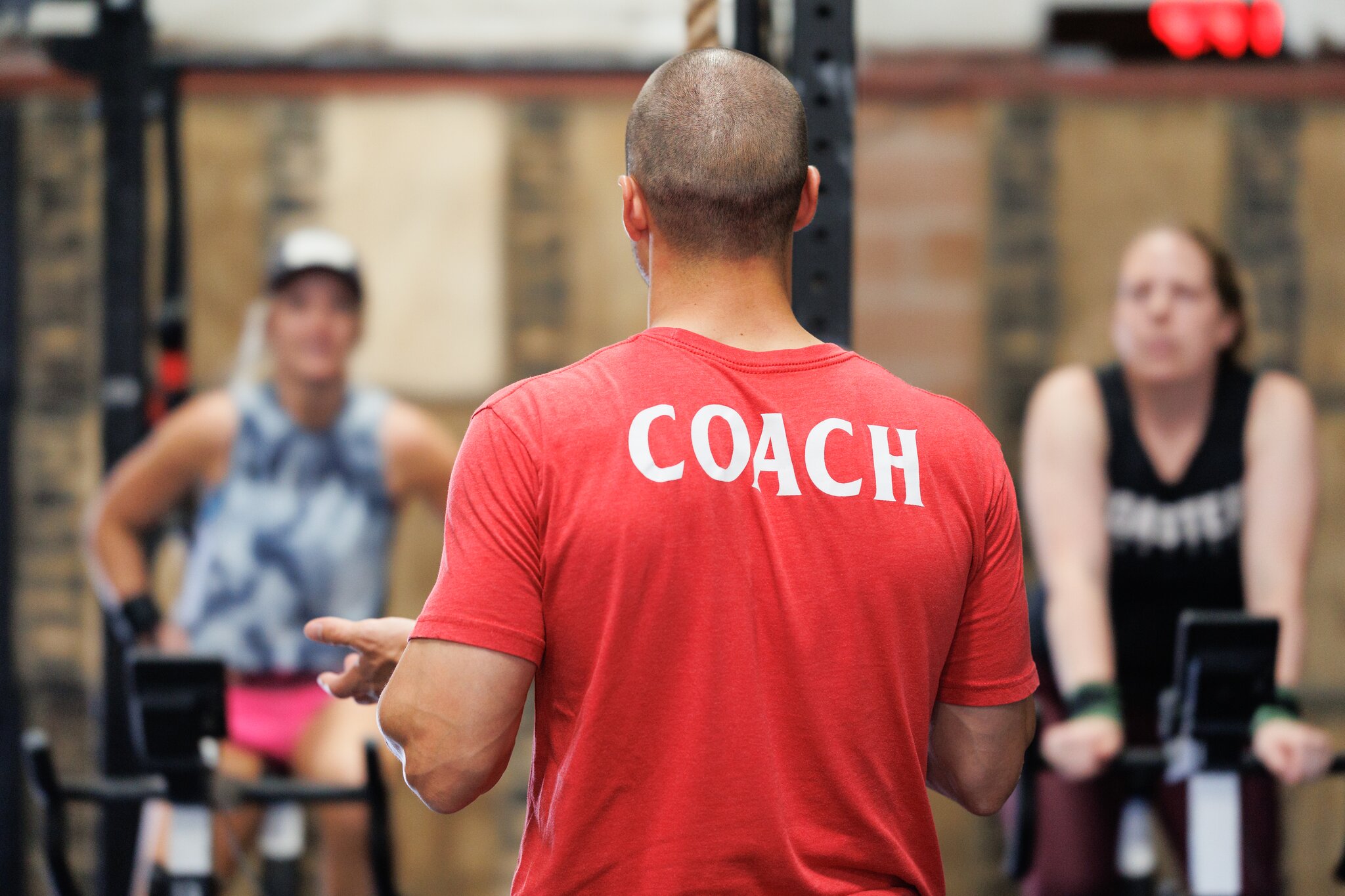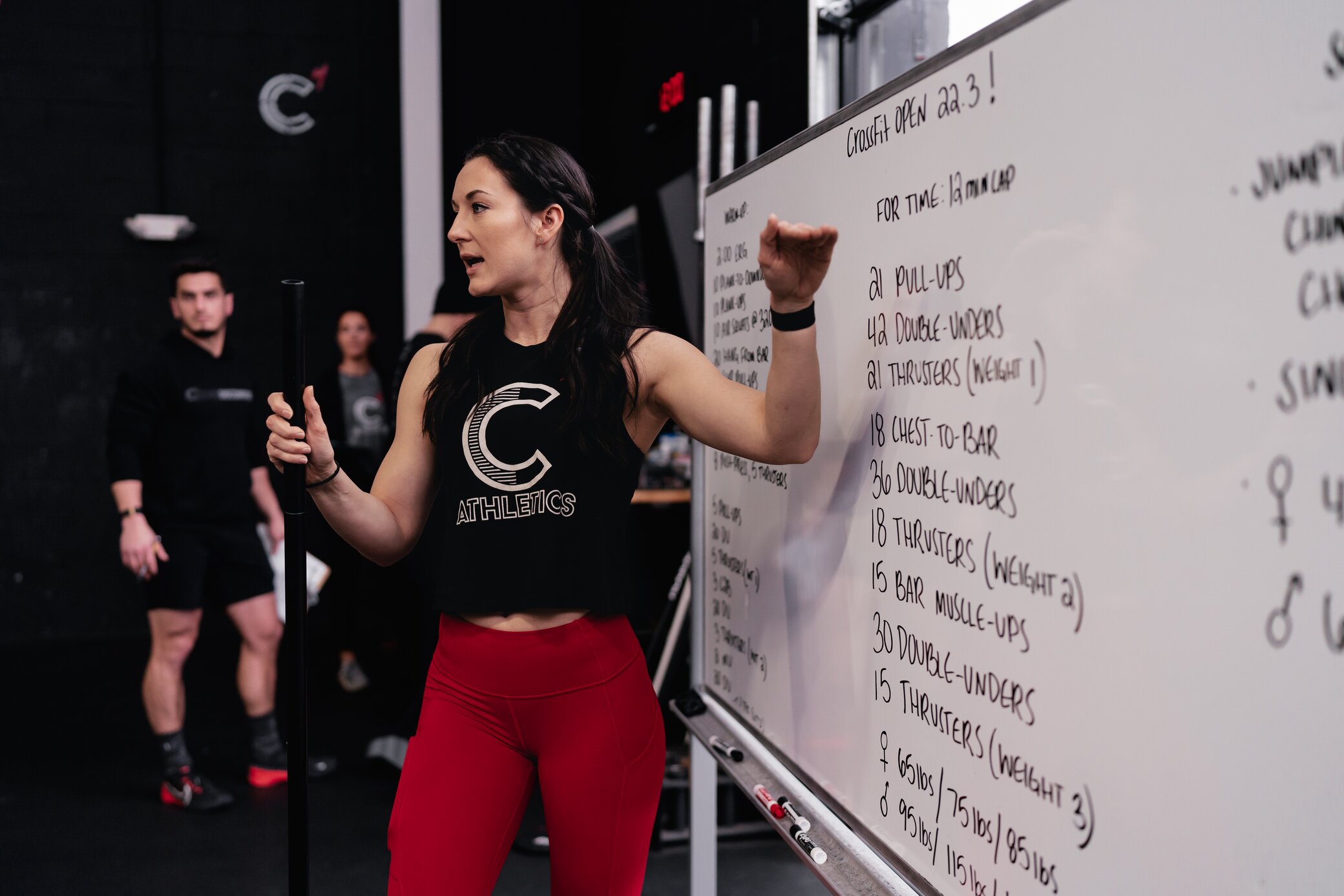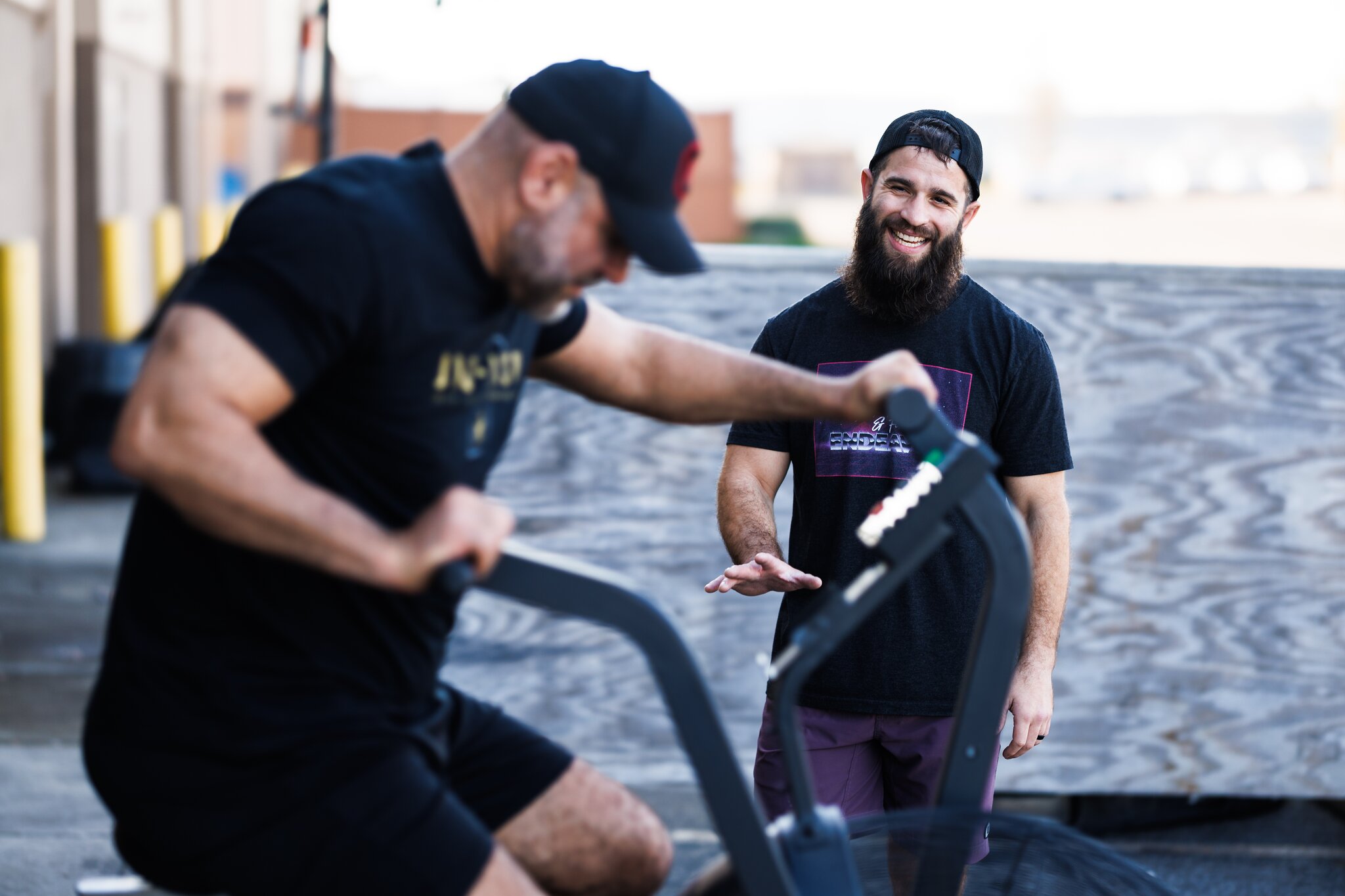“Oh, I know Ryan — he doesn’t squat to depth on air squats.”
The words pierced my soul. I was immediately offended and put up my defenses.
What was she talking about? When has she ever seen me do air squats? I’m almost never in a class with her. I mean, sure, I may have shorted a rep or two trying to blaze through Cindy or Murph, but “he doesn’t squat to depth on air squats” seemed like overkill.
I took a breath, laid down my offense, and acknowledged to myself that there was probably some truth to what she had seen in some previous workout. I then proceeded to do that day’s workout with every air squat unquestionably below parallel.
It was during that morning, attending one of our classes and engaging with the members, that my perspective as a coach shifted dramatically. I realized that everything I did in the box — even when I’m not coaching — mattered.
I was the standard.
As CrossFit coaches, our job is to teach, see, and correct athletes in performing constantly varied functional movements at high intensity. This requires a standard defined by the points of performance needed to safely, effectively, and efficiently execute the seemingly endless movements at our disposal. It is our responsibility as coaches to guide people toward that standard and hold them to it.
But, what happens when we take off that coach’s shirt? My proposition is that your actions matter just as much, if not more. I assure you: The members of your affiliate are watching you, and everything you do defines the standard.
Below, I suggest several standards that I believe we as CrossFit coaches should adhere to in the affiliate. By holding ourselves accountable to these standards, we put on display the ideal we desire for all our members.

Take Your Own Classes
When we write our programming, we write it “as prescribed,” or Rx. The vernacular is appropriate because, within our methodology, we believe we have a prescription to remedy many of the maladies plaguing our society, such as obesity and chronic disease.
The question is, as a coach, do you take your own prescription? If you never participate in your group classes, doing the workout you (or your affiliate) have prescribed, you communicate to your members that there is something better out there. That something other than your programming is needed to achieve the goal of increased work capacity across broad time and modal domains over the span of a lifetime. And if that’s true, then what you really need to do is address the programming you’re prescribing.
The standard is that coaches take classes.
Be On Time
As the old axiom says, “to be early is to be on time. To be on time is to be late. To be late is to be fired.” Clearly, when you’re coaching, you have to be on time. But, as a coach, you should always be on time when you are taking one of the classes at your affiliate.
Punctuality communicates value. Arriving early, if only a few minutes, communicates that you care about the class, the community, and the coach of the hour. Tardiness signals that you’re special. That rules don’t apply to you. That there are those within the walls of the gym who can do whatever they want.
The standard is that coaches aren’t late to class.
Listen
Yes, you know what the workout of the day is. Yes, you know the intended stimulus. Yes, you know the points of performance. Heck, you may have even just coached three classes through this very workout. But that is no excuse for you to stand off in a corner or behind the desk having a conversation with someone while the coach on the floor takes the class through a whiteboard brief or movement demonstration.
When the coach on the floor calls everyone over or is giving any instruction, stop what you’re doing and pay attention. This is especially important when your gym has a number of longtime or experienced CrossFit athletes. They often have the propensity to tune out stuff they think they already know. Your role is to squash that mess.
If you want to go a step further, when you’re there as an athlete, call your friends out. If they’re chatting, walking away to change shoes, or not paying attention, give them a look or a nudge. Call them over as you show them a model of attention.
The standard is that coaches give their full attention and listen.
Follow Instructions
As coaches, we often have specific and well-informed thoughts on what will best prepare our bodies for the workout of the day. However, when the coach on the floor gives instructions for a warm-up that calls for a 200-m run, 10 wall-ball thrusters, and 5 inchworms and you walk over to do Crossover Symmetry, you disrespect the coach on the floor and communicate to your members that the warm-up is optional and doesn’t really matter.
This applies across all areas of the class hour. When a coach says “get this out, “put that away,” “everyone come over here,” or “get up and go walk a 100 m for your cool-down,” you should be the first to comply.
The standard is that coaches follow instructions.

Be Coachable
If the coach on the floor recommends a modification for you, a change in loading, or adjustment to your movement, receive the feedback and follow their guidance. Even if you know as much (or more) than the coach on the floor, unless they are asking you to move in a way that is not safe, effective, and efficient, be coachable and make the adjustment.
Too often, our pride as coaches won’t allow us to learn and grow as athletes. This sets a terrible precedent for our members that taking loading or scaling recommendations is optional.
The standard is that coaches be coachable.
Scale Your Workout
Some CrossFit coaches are amazing athletes and can perform almost every workout as prescribed. However, I’d say that most CrossFit coaches are decent athletes who can perform many workouts as prescribed but also benefit from routinely scaling.
Do not be the person who ignores stimulus (or worse, form and technique) for the sake of checking the Rx button. In my experience, there is perhaps no greater encouragement to your non-Rx athletes than to see a coach scale a workout appropriately. In that moment, they begin to see that Rx isn’t some goal to reach, but that scaling is at the heart of what we do to safely preserve the intended stimulus.
The standard is that coaches perform scaled versions of workouts when appropriate.
Post Your Scores
In CrossFit, we place a value on things that are measurable, observable, and repeatable. If our goal is to increase work capacity across broad times and modal domains, that inherently requires we record the results of our workout.
While the leaderboard provides a level of competition (healthy and beneficial), it is also a collection of data on the growth and development of our work capacity. We want our members to grow, and they need data to do that (and so do you).
Failing to post scores communicates that data doesn’t matter.
The standard is that coaches post their scores.
Every Rep Counts
While we’re talking about scores, it pains me to have to write this one. But, coaches do not cheat. Eight reps is not 10. Toes-almost-to-bar isn’t toes-to-bar. Rollover calories don’t count.
If you’re scaling a movement by reducing reps or something similar, that is great (see the point earlier about scaling). But, if you lie about how many reps you did, there are bigger problems you need to address in your life. Stop lying.
The standard is do not lie.
Follow a nutrition plan
I owe this standard to Jason Ackerman. He recently posted on Instagram that all coaches should follow a nutrition plan. It might be as abstract as “eat clean” or as detailed as the Zone diet we all learned in the Level 1. But, if we believe that nutrition is truly the base of the hierarchy of fitness, then we need to live like it with our actions.
If you don’t give nutrition at least some regular thought and action, it communicates to your members that nutrition doesn’t matter. Coaches should regularly eat a diet primarily consisting of whole, unprocessed foods and routinely experiment with weighing and measuring intake to optimize health and performance. So, figure out what nutrition means for you, your health, and your goals and practice it regularly.
The standard is that coaches follow a nutrition plan.

Squat to Depth
This goes for all movements. No matter how grueling the workout, no matter how bad you’re willing to sacrifice for seconds, never sacrifice movement standards. Your squat is always to depth. Your burpee is always chest to deck. Your toes always touch the bar on toes-to-bars.
The points of performance exist to maximize the safety, efficacy, and efficiency of all movements. We must be the models of sound movement. Not just because it is what we want others to emulate, but because we believe that full range of motion with sound technique is the fastest way to get the results we want.
This shouldn’t be confused with being a perfect mover. Any Level 1 Trainer who walks into their Level 2 course will quickly be reminded that we all need refinement in our movement. But, we should never sacrifice good movement and working toward better.
The standard is the standard
Ultimately, for a coach, the standard is actually quite easy.
Be the athlete you want in your class. Show up on time, engage fully in the class, be humble and coachable, listen attentively, give your full effort, give high-fives and cheer others on, post your (real) scores, follow a nutrition plan, and for goodness’ sake, squat to depth.
Because, trust me, your members are watching, and everything you do is the standard.
About the Author
 Ryan Burns (CF-L2) coaches at CrossFit Addict in Richmond, Virginia. After five years as a part-time coach, Ryan now works full time at Addict overseeing business operations and coach development. He regularly returns to the Level 1 and Level 2 training guides and reminds himself that “regardless of the trainer’s current level of proficiency, a commitment to improving each area is the hallmark of a successful trainer. … A trainer must refine coaching skills across a career to become great. Doing so develops virtuosity in coaching.” (Level 2 Training Guide and Workbook)
Ryan Burns (CF-L2) coaches at CrossFit Addict in Richmond, Virginia. After five years as a part-time coach, Ryan now works full time at Addict overseeing business operations and coach development. He regularly returns to the Level 1 and Level 2 training guides and reminds himself that “regardless of the trainer’s current level of proficiency, a commitment to improving each area is the hallmark of a successful trainer. … A trainer must refine coaching skills across a career to become great. Doing so develops virtuosity in coaching.” (Level 2 Training Guide and Workbook)
Comments on The Coach Holds the Standard
NICEEEEE \o/
Você é pego de exemplo, mesmo que você não imagine ou queira- liderar pelo exemplo. (Demonstração - Manual e Guia de Treinamento Nível 2, pag 21)
“Doing the common uncommonly well” não se aplica apenas ao movimento; também pode ser aplicado a qualquer habilidade particular. Treinadores de CrossFit buscam a excelência em todos os aspectos de sua técnica, sempre com a intenção de melhor atender àqueles que confiaram sua saúde a eles.
artigo de excelencia!!!obrigado
Great article, thank you Ryan! Simple, effective rules to coach by...and to live by; love it.
A good coach is really something that help you. I had some coach not in crossfit but some martial arts that was so bad that i lost years of pratice. A good coach also always push you a lot. And it is necessary if you want to develop more. I also read a good article about training on this website video buzzy.
Anyway thanks for this good article i save this one in my fav
Maravilloso! Ojalá todos puedan leer y no dejar pasar por alto estas líneas. Alto al ego!!
I agree whole heartedly with the idea that the coach sets the standard, and with all but the 1st piece of advice. I think a coach should coach his classes rather than participate in them. He can do the workout in another trainer's class.
I think this is exactly what he means Daniel. The way I read this is that each coach should be seen to be participating in the same class as the members, albeit when being lead by another trainer. The point being, if the whiteboard is good for the members it should be good for the coaches. If the coaches go ahead and follow another workout prescription they're then showing a lack of belief in the programme they're delivering to the paying customer
Hope this helps with understanding the point a little differently :-)
Yes, a coach should not workout in a class she or he is coaching. The article is referencing when a coach (employee of the gym) is participating as a regular member of the community. Hope that clears it up.
Ryan, this wonderful article beautifully articulates the foundation needed to establish a great culture. Thank you for this. My team will be reading and discussing this at our next staff meeting.
Thanks, Nicole. Thanks for helping me always remember that "the standard is the standard." We coaches just need to hold to it!
Excelente, sigo sus capacitaciones online desde Guatemala
This is GOLD.
Thank you for this reminder! Passing to my coaches.. and re-reading for myself!
Great read and very true, thanks! Proud of many of these aspects we do well at our affiliate!
Same here Timo. Greets
A good reminder that everything we do in and outside of classes matters 🙌🏻 Thanks for a great article!
A great reminder, brought to the point: CrossFitters are role models, and it all starts or ends with us coaches! I would even say that these rules help us in every situation of our lives, inside and outside the gym.
100% Thanks coach. ✊🏼🔥
Good stuff coach.
awesome article.
100% Every single person should read this, coach or athlete.
Totally agree, Grace. The standard is the standard.
This is a great article! Solid standards for all coaches..
All tenets in my current gym, but well said sir!! Will be printing and sharing!!
Well written article. Thank you!
Great read!! Will definitely be sharing this by and referring back to it!
Great article, wonderfully simple and very compelling. Thanks Ryan!
This is a wonderful article! Thank you!
The Coach Holds the Standard
28